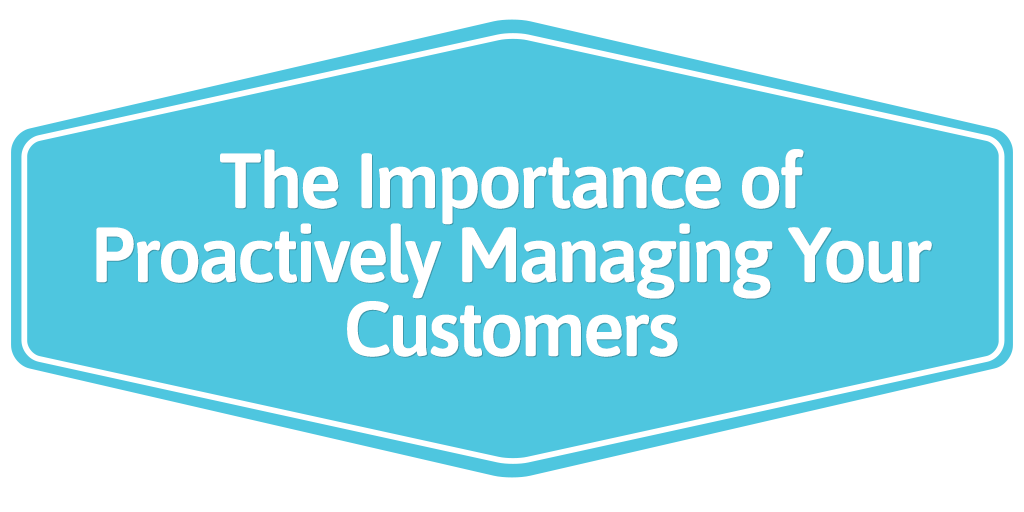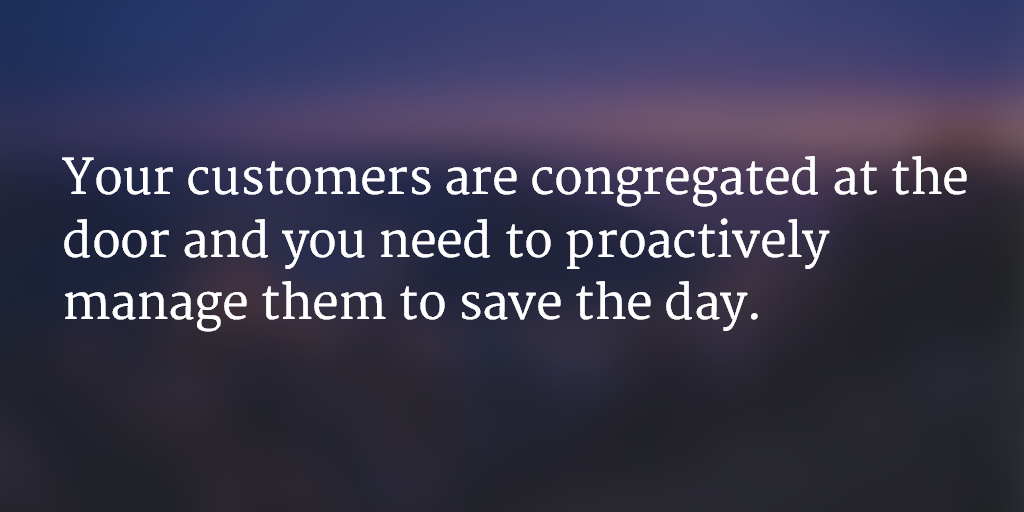
Your customers are about to walk away and the blame is entirely on you.
Right before they hit the ‘Cancel’ button, your customers were busy evaluating competitors, looking at the shortcomings of their business, and thinking about how frustrated they were with what they were hearing from you. Meanwhile, you were – what, exactly?
This happened because you weren’t proactively managing your customers. Proactive management means that you are ensuring that your customers aren’t just satisfied but ecstatic. It means that you’re focused less on your pet projects and more on what will result in customers succeeding. It means that you aren’t waiting around for a customer to complain to you or brush you off as they cancel, but that you’re actively going out of your way to keep the lines of communication open.
Your customers are congregated at the door and you need to proactively manage them to save the day. This is our guide on why proactive management is important and how to do it.

What You Need to Start Proactively Managing Customers
Before you start sending out emails to customers with the subject line, “I’m ready to proactively manage your account,” you need to find out a few things. There are three pillars to put up that will transform your customer management from a sputtering effort to a profit driver.
Know the Needs They Aren’t Sharing
Your customers have come to you so you’ll help them solve a problem. It doesn’t matter if it’s maintaining their servers, distributing physical goods, managing a marketing campaign, or something else – they expect you to deliver. However, just because they’re employing you to solve one problem doesn’t mean that they don’t have other problems you could be solving that you don’t know about. To improve your customer management, you need to find out what these unspoken problems are.
Unless you’re reading this in the future and telepathy has come about, the only way to learn these problems is to get your customers to tell you. While asking directly might work in some case, more often than not you’ll need to create the perfect question. For example, asking your customer, “Are we doing a good job?” will get you a yes or no answer. This might be interesting to know, but it’s far more useful to ask open-ended questions like, “How has our product failed you in the last month?” As your customer answers and the conversation develops, you can find out the root of their problem by methodically asking probing questions.
Know If Your Customers Are Informed
How many of your customers know about that feature update you launched a month ago? Well, there are two places you can look to find out: your announcement email and your analytics.
Assuming that you sent an email to your customers announcing the new feature, it’s simple to open up your email marketing tools and see how many customers opened the email. Chances are, the number is less than 40% of the total number of recipients.
On the analytics side, you can quickly see how many people have used the new feature and compare it to the historical numbers from the pre-launch period. While it’s smudging the numbers a bit, the difference between the two time periods is the result of people finding out about the feature launch.
Why does this matter? Both of these are excellent proxies for whether or not your customers are informed about what’s going on with your business. While the occasional email sharing a blog post is an excellent start, this doesn’t share the full picture with your customers. Without them knowing what’s going on with your company and your plans for the future, they won’t feel invested in where you’re headed.
Check If There’s a Personal Connection
In addition to knowing your customer’s real needs and knowing if your customers are in the loop, you also need to know if there’s a personal connection between someone on your team and a specific person on their team. Look at how frequently your respective teams were in contact and whether or not the messages were Black Tie Formal (“Dear X, This is Y from Acme, Inc.”) or Business Casual (“Hey X, Checking in to see how things are going…”).
This might seem like a small detail, but a personal connection is a fundamental building block of proactively managing your customers. Without a relationship that has at least reached a first-name basis, you’re in for an uphill battle. It will be nearly impossible to find out what your customers are really thinking, and when they start to head for the door it’s unlikely that they’ll give a faceless automaton a heads up.
How You’re Going to Do It
Once you know where you currently stand with your customers and how well informed your patrons are about your business, you need to actually start proactively managing. We’re going to get you started.
Research Interviews
Your customers aren’t going to suddenly volunteer mountains of structured data that will pinpoint how you can help them. You need a reliable method that opens up a dialogue, gets good answers from interviewees, and builds rapport between the two teams. What you need to do is hold research interviews with your customers on a regular schedule.
Research interviews have two primary benefits. Not only do they get you the information you need to evolve your product in a way that helps customers, but it also strokes the ego of your customers and makes them feel essential. A typical customer that gets an email asking for their unique input in a research interview is going to feel thrilled that someone wants to listen to them.
The Magic of Phones

While texting has largely replaced phone calls in hundreds of millions of relationships, the phone still holds tremendous sway in the business world. Unlike email and surveys, when you communicate with customers over the phone you’re able to hear every pause, catch the intonation in their voice, and better understand what your customer is really trying to communicate.
This hidden communication is key to understanding what your customers want, which is the most important question to answer when proactively managing your relationships. Once you know this, you’ll be able to build products and features that your customers need. Along the way, you’ll build a business that helps customers succeed and becomes indispensable.
Constant Correspondence
Phone calls are great, but many people hesitate when asked to jump on a phone call with a stranger. To build a bridge over these troubled waters, start by opening up an informal correspondence with your customers. Simple emails that disregard pretense and treat people like friends pave the way to honest relationships.
To do this, every time you think, “but would customers want this?” send an email to one of your customers. It shouldn’t be the same customer every time (that’s called spam), but you shouldn’t hesitate to reach out to the people that are buying what you’re selling. Don’t make strategic decisions based on the say-so of one person, but at the same time there’s no substitute for the feedback of a real customer – most importantly, it helps you break free of your internal echochamber and brings the focus back to the customer.
Final Thoughts
When you start by understanding where you stand with customers and then begin to take meaningful steps to improve the relationship, your business will grow and improve. Not just when it comes to cutting the number of cancellations, but also the number of enthusiastic referrals and overall customer satisfaction.


